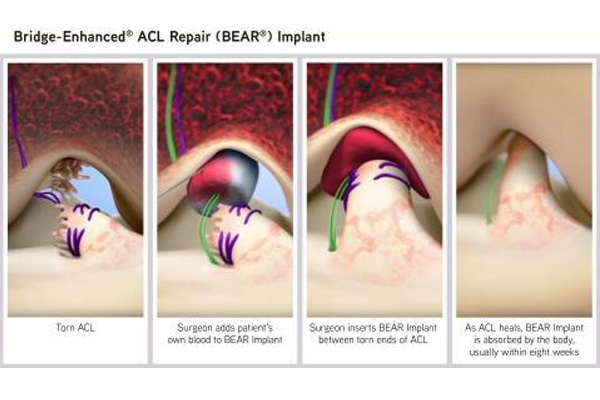
The BEAR (Bridge-Enhanced ACL Repair) procedure is an innovative technique for repairing anterior cruciate ligament (ACL) tears. Unlike traditional ACL reconstruction, which involves replacing the torn ligament with a graft (from either the patient's own tissue or a donor), the BEAR procedure aims to preserve and heal the patient's original ACL using a special scaffold.
Key Features of the BEAR Procedure
-
Preservation of the Native ACL
- The BEAR procedure focuses on repairing and healing the patient’s own torn ACL rather than replacing it with a graft. This approach maintains the natural anatomy and potentially the proprioceptive function of the original ligament.
-
Use of a Bioactive Scaffold
- The procedure involves the insertion of a bioactive scaffold made from a bovine-derived protein. This scaffold is designed to bridge the gap between the torn ends of the ACL.
- The scaffold is soaked in the patient's own blood, which provides the necessary growth factors and cells to promote healing.
-
Promotion of Biological Healing
- By using the patient's blood and the bioactive scaffold, the BEAR technique encourages the body's natural healing processes to repair the torn ligament.
- This method aims to restore the ACL to its pre-injury condition, preserving its natural function and biomechanical properties.
Procedure Overview
-
Preparation
- The patient undergoes a standard arthroscopic procedure to visualize and assess the ACL tear.
-
Placement of the Scaffold
- The bioactive scaffold is soaked in the patient’s blood.
- The surgeon inserts the scaffold into the knee joint, positioning it between the torn ends of the ACL.
-
Suturing
- The torn ends of the ACL are sutured together with the scaffold in place, creating a bridge that facilitates healing.
-
Healing Process
- Over time, the scaffold helps the body to regenerate the ligament tissue, promoting the reconnection and strengthening of the torn ACL fibers.
Advantages of the BEAR Procedure
-
Less Invasive
- The procedure avoids harvesting graft tissue from other parts of the body, reducing additional surgical trauma and potential complications at the donor site.
-
Potential for Better Proprioception
- Preserving the native ACL might maintain better proprioceptive function compared to traditional grafts, potentially improving joint stability and function.
-
Reduced Risk of Graft Failure
- Since the original ligament is repaired rather than replaced, the risks associated with graft failure or complications from donor tissue are minimized.
-
Faster Recovery and Rehabilitation
- Patients may experience a quicker psychological recovery and less post-operative pain compared to traditional ACL reconstruction, although this can vary individually.
Considerations and Limitations
-
Eligibility
- The BEAR procedure is not suitable for all patients. It is generally indicated for patients with proximal ACL tears (near the femoral attachment) and may not be appropriate for those with more complex or chronic tears.
-
Long-Term Outcomes
- While early studies and clinical trials show promising results, long-term data on the effectiveness and durability of the BEAR procedure are still being gathered.
-
Availability
- As a relatively new technique, the BEAR procedure may not be widely available and is typically performed by surgeons specialized in sports medicine and orthopedic research centers. Dr. Catherine Logan has been performing the BEAR procedure since 2021.
Summary
The BEAR procedure represents a novel approach to ACL repair that focuses on biological healing and preservation of the native ligament. By using a bioactive scaffold and the patient's own blood, this technique aims to facilitate natural tissue regeneration and restore the ACL’s original function. While promising, it is important to consult with an orthopedic surgeon to determine the best treatment option based on individual circumstances and the specific characteristics of the ACL injury.

